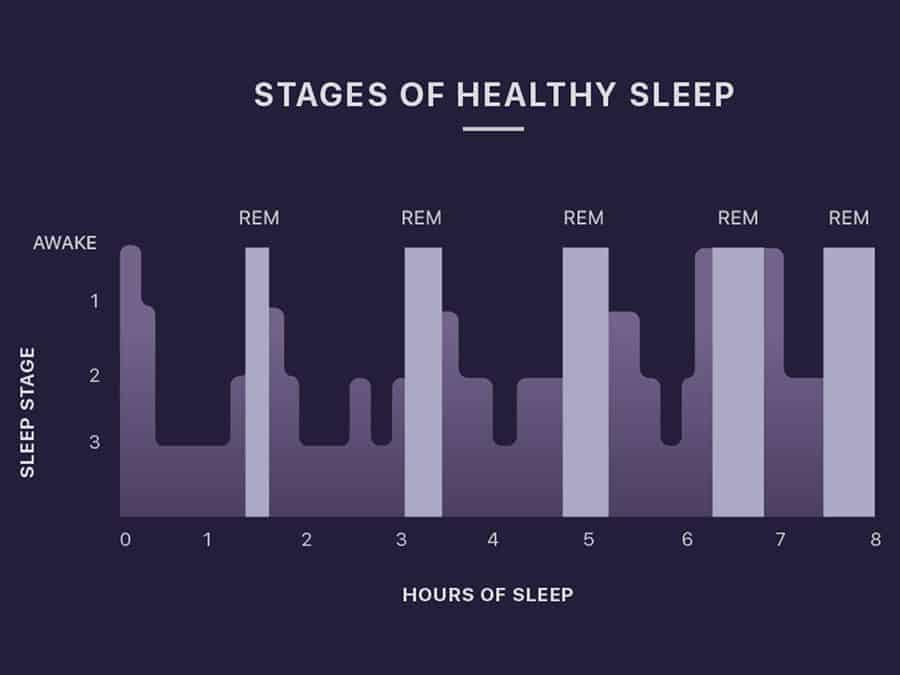Stages of Sleep Cycle: Simply Explained
Sleep is an unconscious state that can be awakened by appropriate stimuli. Broadly it’s a state of mind and body that usually repeats for several hours each night, the nervous system is relatively inactive, the eyes are closed, the posture muscles are relaxed, and consciousness is actually exposed. Sleep is a platform for nutrition, exercise and mindfulness. But these pillars of your health aren’t as efficient as when your sleep isn’t working. Sleep may look like a steady state, but it actually consists of several phases that circulate during sleep.
The types of brain waves present at the time determines the stage of sleep. There are mainly two types of sleep.
- Slow-wave sleep (Non-REM)
- Stage 1
- Stage 2
- Stage 3
- Stage 4
- Rapid Eye Movement Sleep (REM)
Non-REM and REM sleep alternate in cycles during sleeping. Slow wave sleep Occurs during first hours after sleep. Decrease in vascular tone & vegetative functions observed in this stage. REM sleep is a rapid explosion of eye movements while dreaming. Inhibition of somatic motor neurons occurs in this stage.
A complete sleep cycle takes about 90 to 100 minutes. During the average sleep period, a person experiences 4-5 complete sleep cycles. The sleep cycle begins with four levels of Slow Wave sleep (non-rem).
After completing Stage 4, Stage 5 (REM) does not start immediately. Instead, the first four phases are immediately reversed, followed immediately by the REM phase. The first REM phase occurs about 90 minutes after falling asleep. Therefore, the length of each sleep cycle is about 100 minutes, so the initial REM period is only about 10 minutes.
Sleep Stages And Brain Activity
The period of non-REM sleep is comprised of Stages 1-4 and lasts from 90 to 120 minutes. Surprisingly, Phases 2 and 3 are repeated in the opposite direction before reaching REM sleep. REM sleep occurs 90 minutes after falling asleep.
Stage 1 (Drowsiness)
Stage 1 lasts just one to five minutes. Eyes move slowly under the eyelids, muscle activity slows down, and can be easily awakened. Stage 1 lasts about 1 to 5 minutes.
Stage 2 (Light Sleep)
Stage 2 is the second stage of sleep, which lasts about 60 minutes. The eyes will stop moving, the heart rate will drop, and the body temperature will drop. Stage 2 lasts about 10 to 60 minutes.
Stages 3 (Deep Sleep)
Deep, slow brain waves, known as delta waves, begin to appear during level 3 sleep. Stage 3 is the transition between light and very deep sleep. Stage 3 lasts about 20 to 40 minutes.
Stage 4 (Deep Sleep)
Stage 4 is also called delta sleep because it is the time when slow brain waves called delta waves occur. Stage 4 lasts about 10 to 60 minutes.
REM sleep (Dream Sleep)
REM sleep usually occurs 90 minutes after falling asleep. The first REM phase usually lasts 10 minutes, each recurring REM phase is longer, and the last phase can last up to an hour. The rate of REM sleep is highest in infants. The rate of REM sleep decreases in adolescence and young adulthood.
As the night progresses, the stages of REM sleep become longer, especially in the second half of the night. The first REM phase takes only a few minutes, but later phases can last about an hour. Overall, REM sleep accounts for about 25% of adult sleep.
At the end of REM sleep, the body returns to normal level 2 sleep. Sleep cycles through these stages approximately 4 or 5 times throughout the sleeping time.
The following table shows a summary of the stages of sleep:
Sleep Stage | Brain Waves | Common Characteristics |
|
1 | Frequency 4 to 8 Hz and Wave types are alpha, theta |
|
|
2 | Frequency 8 to 15 Hz and Wave types are alpha, theta |
|
|
3 | Frequency 2 to 4 Hz and Wave types are delta, theta |
|
|
4 | Frequency 0.5 to 2 Hz and Wave types are delta, theta |
|
|
5 |
Frequency >12 Hz and Wave type is beta |
|
How Much Sleep Do You Need?
The amount of sleep a person needs depends on the individual. The need for sleep depends on various factors, one of which is age. Infants usually need about 16 to 18 hours of sleep per day, while teens need about 9 hours per day on average. Most adults need about 7 to 8 hours of sleep a day.
Too little sleep may cause impaired memory and thought processes. It also causes depression and decrease immune response.
Sleep deprivation also enhances pain perception in pain simulation tests. Caffeine and other stimulants can temporarily overcome the effects of severe sleep deprivation, but not for the long term.
Each sleep stage plays a part in allowing your mind and body to wake up refreshed. Understanding the sleep cycle also helps explain how certain sleep disorders, including insomnia and obstructive sleep apnea can impact a person’s sleep and health.
